
15 minute read
A bit of a problem

‘Blizzard’ won 2nd place in the 2018 Australian Photography Awards, as well as the People’s Choice Award in the same year. TOP: Rising from the flames: Two bachelors sparring within days of the fire that swept through Kosciuszko National Park.
RIGHT: These Brumby youngsters are as interested in Carol and she is in them. that had just happened. A wave of euphoria washed over Carol. Here she was, in the middle of a snowstorm, and witness to a tiny fillies very first steps. As she snapped some photos of the freshly born foal, she realised she was disengaging from the moment and put away her camera. “Is it about the photograph, or is it about the experience? For me, being so close to that particular mob, it was about the experience. So I wasn’t chasing the perfect quality photograph that time,” Carol reflects.
When they think of Brumbies, many people have romantic visions of wild horses galloping freely down a mountainside with long manes and tails flowing behind them. Unfortunately, the reality of life for many of these horses is competition between mobs during times of drought, and death due to injury, disease, snakebites or environmental crises such as the recent bushfires, which swept through many parts of Australia. There are also claims that Brumbies cause damage to National Parks and that their numbers are too high: “I’m pro-management and proBrumbies. If the numbers get too high, they become unhealthy, because they’re fighting for their territories. They’re fighting constantly with each other and for resources,” Carol explains.
“But do I agree with the current plans? I am comfortable with passive trappings, but I am not comfortable with anything that is not transparent, nor am I comfortable with the shootings. There needs to be a tracking and identification system so there’s a way that we can monitor the herds, where they go and where they end up. I would absolutely love for everyone to come together and figure out a plan that works for everybody.”
Over the years, Carol has observed many Brumbies and has come to realise that our knowledge and understanding of them isn’t great. So, not only is she passionate about photographing them, she’s also passionate to learn more about them: “Why don’t we study the Brumbies? Why don’t we bring them in,

tag them and then send them out,” she asks. “Let’s have a really good look at these herds and learn more.”
In her pursuit of understanding, Carol has teamed up with two Snowy Mountain locals, a land owner and an experienced horsewoman, and together they’ve been granted an application to bring five Brumbies down from one of the Snowy Mountains trap sites. Carol will spend time documenting, photographing, and blogging about the horses “from the minute they come in, to the minute they go to their new home,” she explains.
In what will be an immersive storytelling and photography journey, Carol is hoping to create awareness around the Brumbies. “That’s what we need. People think that Brumbies are inbred and certainly, as any horse breeder knows, some matchings and matings don’t work – that’s the way it is. In some areas, the Brumbies are definitely lighter in the body than in others. In the Kiandra area especially, they’re very robust and kind to the eye. I believe training them and raising awareness is something that they can only benefit from.” collection of Brumby photographs it’s difficult to believe that anyone could find these majestic horses to be anything less than beautiful. Each photo uncovers a new dimension to these wild creatures and brings into focus their strength and grace.
“When I go out and photograph, I’m not choosing what’s in front of me – these horses are roaming in thousands and thousands of acres and I’m not choosing. They are not handpicked – they are what I find on that day and as such they’re a good example of the quality of horse out there. So if we can create an awareness of their potential, then maybe it will be easier, more feasible, to rehome them,” she says.
Carol finds photographing Brumbies endlessly interesting - as are some people’s reactions to her area of expertise! “It’s not that people don’t take you seriously, it’s that they ask you questions like, why are you photographing a feral animal,” she laughs. “A lot of people don’t perceive it as true photography. My question is, what is photography? Photography is a platform for art, it’s the platform of your mind’s eye. So to me, it is true photography. Although I’m portrait trained, this is what I want to do, and this is what makes me happy.”
Indeed, Carol brings immense vision and artistic grace to her work by expressing her passion for the wild horses of the Snowy Mountains, and by introducing them to us – face to face.
FEATURE
During her 10 years as a fully qualified equine dentist, ANNA MINOGUE had seen numerous bit related injuries. Determined to do what she could to remedy the problem, she decided to become a bit fitter.
Are you becoming concerned by the way your horse grabs or chews on the bit? Or perhaps they’re tilting or tossing their head, an annoying habit that you can’t seem to remedy. And why is it that they appear unwilling to accept proper contact with the bit? All these issues can be frustrating, and more than a little puzzling - but the answer might just come straight from the horse’s mouth!
During her career as an equine dentist, Anna Minogue has seen over 20,000 horses’ mouths, and, as you might imagine, is more than familiar with the anatomy of the mouth and its relationship to bitting. Sadly, she has also seen hundreds of horses with wounds caused by ill-fitting bits, which is what launched her on her trajectory as a bit fitter. A veterinary nurse in a previous life, she’s the first Australian to study with the prestigious International College for Professional Bit Fitting Consultants in the Netherlands, and has also trained with Horse Bit Fit UK, Bombers Bits, and The Academy by Neue Schule, as well as attending a Society of Master Saddlers bridle fitting workshop. Unlike many bit fitters, Anna doesn’t work for a bit company, nor is she a bit retailer. She prefers an unbiased approach to ensuring that horses are as happy and comfortable in their work as possible, and is committed to matching each horse with the right bit, no matter what the brand.
In the course of her career, Anna has discovered what she calls a “huge disconnect” when it comes to the correct fitting of bits. “Much of the knowledge out there is out-dated and often incorrect – it’s what I was taught at Pony Club 30 years ago. There are now many more bits and much more science based research than there once was, and I think that as owners, we need to keep up with that. The physical consequence of the knowledge vacuum is that mouth wounds are really common. Then you’ve got the training issues stemming from that, because often times riders don’t look inside the mouth and don’t know that there’s a wound. They continue to ride the horse, the horse is completely over being in pain and then you get a raft of bad behaviours stemming from that problem: everything from bolting to rearing - lots of unwanted and unnecessary habits.”
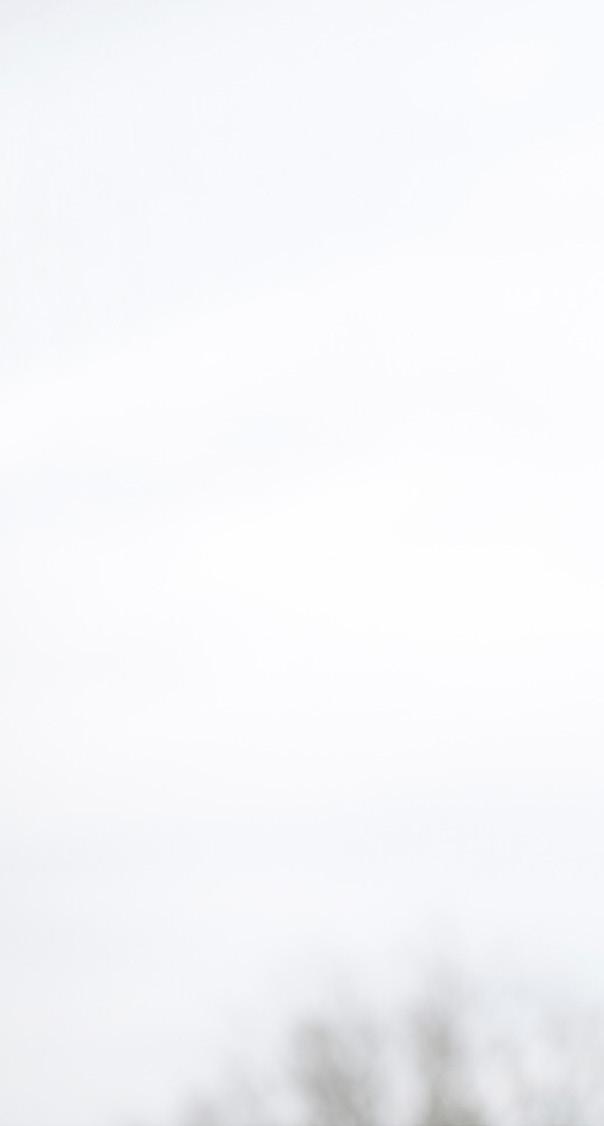
However, whether a horse reacts to a mouth wound depends very much on its temperament. “There’re horses being ridden with badly fitted saddles that never complain. But there’re also horses that are a little like the princess and the pea! It can be a very small something that’s off and it throws the horse into a state of not being able to think about anything else other than the pain. The same goes with bits, and it’s our responsibility to get to the bottom of these problems. So yes, you can have horses with some pretty hideous mouth wounds and you wouldn’t know they were there. The horse isn’t showing any signs of negative behaviour under saddle, but you open the mouth and they’ve got awful wounds. In the case of a horse who is reacting to pain, you fix the wounds and the bit, and the bad behaviours disappear. The owner is amazed at what a good horse they suddenly have!” Anna laughs.
Of great concern to Anna is that damage from a poorly fitting bit can sometimes be permanent. “Things like bone spurs on the bars are not uncommon. If you feel the two bones that form the bottom jaw, they’re quite sharp between the incisors and the first canine tooth and
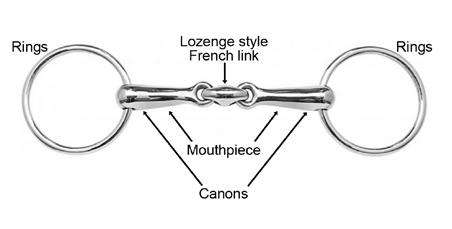
they’re very sharp right up to the first molars. The problem is that there’s only a small amount of tissue covering those bars and so if the bit slides around it can cut the tissue and cause so much rubbing on the bone that it begins to overdevelop and then you get spurring – and that’s irreversible,” Anna explains.
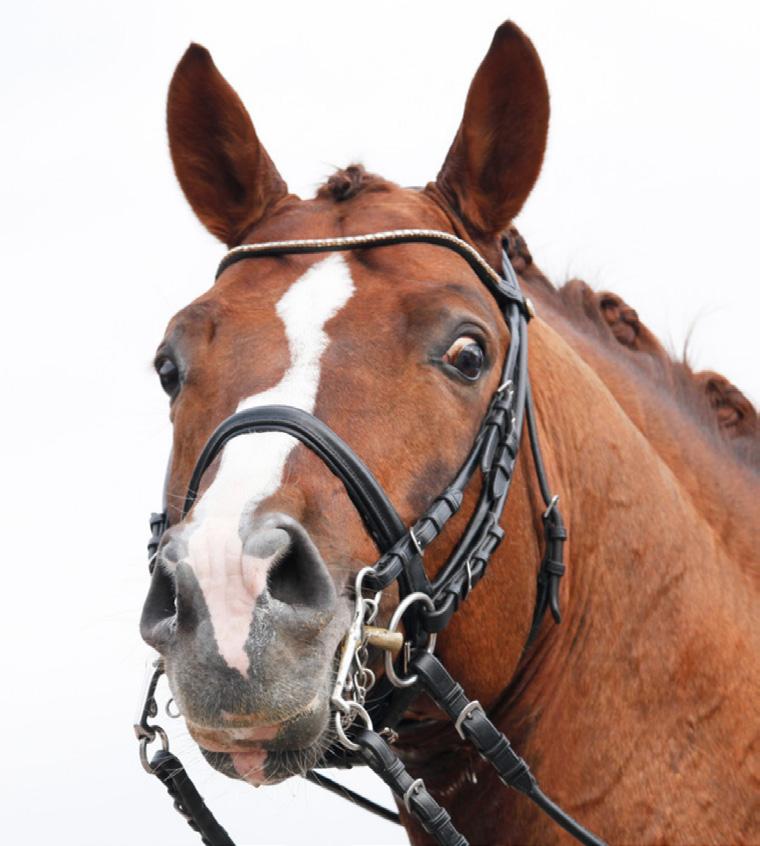
Although the average rider isn’t strong enough to break a horse’s jaw, they can certainly do permanent damage to the bars if they’re using an ill-fitting bit. And the old adage that the bit is only as strong as the rider is true! Even very soft, well-fitted bits can do damage in bad hands.
Tongue ties, most commonly found in the racing industry, can all too easily result in nerve damage. Used to prevent the horse from getting their tongue over the bit, they’re generally made of a strip of cloth or rubber, which is passed through the mouth and tied below the chin. “Any permanent strangulation of the tissue can cause it to die – and I’ve seen some pretty badly affected tongues,” Anna says.
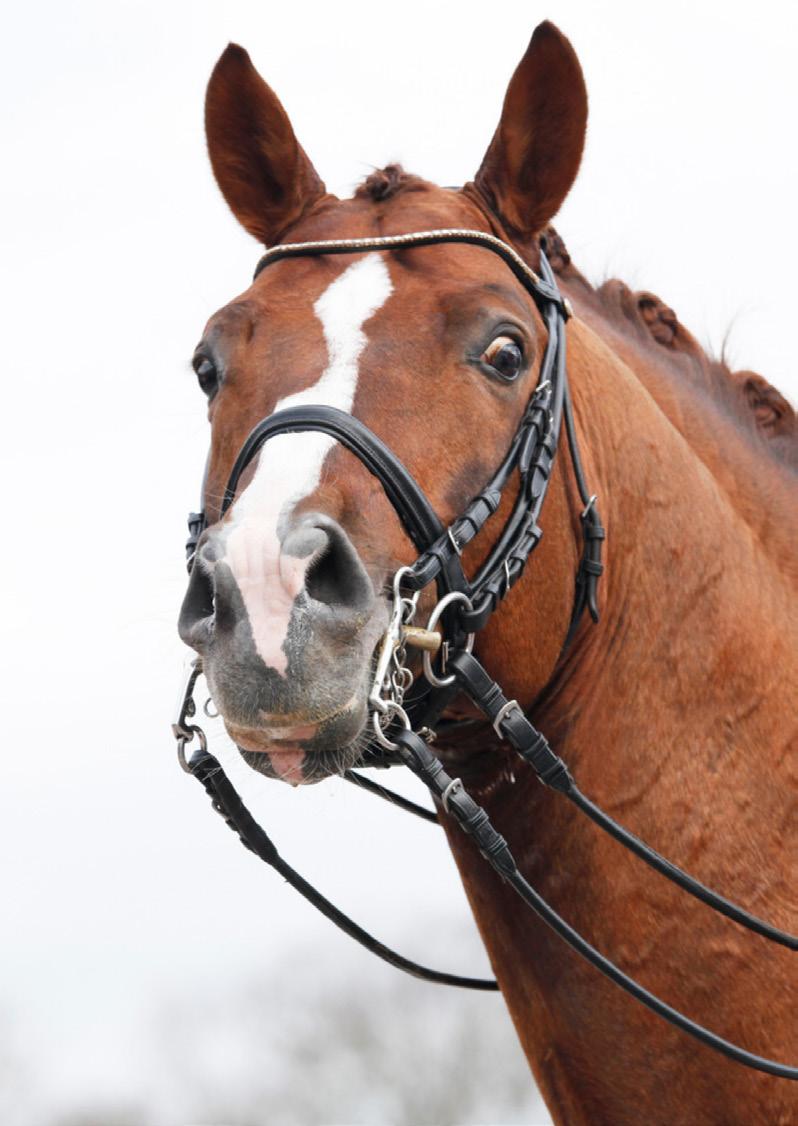
In Anna’s opinion, every horse owner should check their horse’s mouth for signs of abrasions and wounds. However, when it comes to determining whether your horse has an anomaly that should be accommodated when

fitting a bit, things become a little trickier. “People often tell me that their horse has, for example, a really low palate. Yet when I have a look, the palate is perfectly normal. But I’ve seen numerous mouths in my career and can easily determine what’s normal and what isn’t, whereas for someone feeling their horse’s mouth for the first time it’s very difficult to ascertain whether there’s an issue or not,” she explains.
And that’s where the services of a professional bit fitter are invaluable. “People are spending thousands of dollars on bits because someone on social media suggested a certain bit, and then they find it’s not right for their horse so they go and buy another, and another. A lot of the people I see have a bit collection that rivals my bit fitting kit, and still they can’t find anything to work on the horse. So I start by looking at the horse’s anatomy, the rider, the horse’s attitude and level of education, and come up with different options from there. It’s never easy. If you only think your horse has wide bars and someone suggests a particular bit, it’s usually not going to work out,” says Anna.
So how do you know if your horse needs a bit fitting? “When a potential client calls me, I always ask if their horse has an understanding of what the bit does. Does the horse understand that loosening off the reins doesn’t mean go faster? Can your horse walk, trot and canter on a long rein? Do they understand that they shouldn’t run away from, or run into the rein? These are all training issues. You see a lot of horses that are held in a frame and their rider thinks they’re on the bit, there’s correct contact, and they're properly collected. But if you loosen the rein, the horse runs away. To me, that’s not true collection and no bit will fix that very common problem. That’s a fundamental training issue,” she explains.
While Anna says that she could put a stronger bit on a horse to stop them running, it’s not ethical to do so. “The same thing will happen with the stronger bit but the horse is in more pain. The horse needs a thorough understanding of the aids. It’s not fair to inflict yet more pain and the horse still doesn’t understand what it is you want. So they need to go back to flatwork, back to the very basics. If, on the other hand, people have tried a lot of bits and they know that the training is good and that the horse understands what the bit means – then yes, a bit fitting is often an appropriate next step.”
In broad terms, Anna believes most horses prefer a double jointed mouthpiece over a single joint, while many horses like a 'lozenge' centre rather than the flat centre piece typical of a double jointed French link bit. Some fussier horses sometimes prefer a straighter Mullen style bit, while others may prefer rubber over metal.
When it comes to shape, Anna suggests that you hold the bit by the rings, and opt for one that creates a ‘U’ shape
Dire consequences
Ill-fitting bits can cause some truly horrible wounds, as these images, captured by Anna during the course of her work, clearly demonstrate:
Injury to upper lip and lip commissure
This injury to the upper lip and lip commissure (the corner of the mouth) was caused by a bit that was too large and too thick. The bit sliding from side to side has caused friction burns.
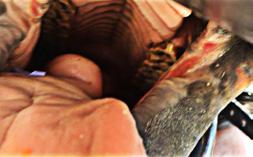
A pinch wound caused by a jointed bit that was too large. The sliding of the bit has caused the joints to grab the lip tissue and pinch it, causing blood blisters. This is the most common bitting wound that Anna sees.
This is the result of a ported hard plastic bit that was fitted too low and wide. The bit also had some hard plastic shards from being chewed. The movement of the bit has caused the horse to move their tongue away in discomfort and as a result, the bars have become severely damaged by the sideways, forward and backward slide of the bit, as well as the plastic shards rubbing on the delicate mucous membrane tissue.
Pinch wound


rather than one that’s ‘V’ shaped. “A curved bit is anatomically more comfortable than a bit with straight canons, which often don’t encourage contact. And when considering bit thickness, measure the diameter of the canons closest to the rings. Horses vary in what they prefer but 12-14mm is a good middle option, while most horses will not be comfortable in anything thicker than 16mm.”
Of all the bits that are available, there are some that Anna prefers to avoid: “I don’t like using hard plastic bits, I find them quite problematic. If the horse chews on them, it can create really nasty rough ridges that will rub on the lip and the mouth and give quite bad wounds. If you’re using that type of bit, check it regularly and sandpaper any ridges or jags down. If the bit is a softer plastic it’s not such as problem because it doesn’t create the rough ridges that do damage. So be very wary of any bit that’s made from material that could mark and
cause damage to the mouth – they’re definitely the ones you have to be very careful with.”
And some final words of advice
from Anna: “Check your bit regularly for any rough edges and if it’s a loose ring, make sure the rings are sliding smoothly – those are good points to check when buying a bit too. And please, clean your bits after every ride. Caked on dirt and saliva can also cause wounds.”
For more information on Anna’s services, visit www.thebitfitter.com, drop by her Facebook page, or call her on 0407 689 155.

Damage to the tongue and bars

A bit with a curve is more comfortable for your horse.
Statford Neo

At just 6 years of age Statford Neo took out the prestigious Adelaide International 2*, just as his sire, Statford Novalis had before him. Now his own progeny are stepping up with his talented son Kings Basil Brush putting himself on notice as a serious eventing horse. Neo has been ACE eventing Horse Of The Year on 3 occasions. His full sister Statford Nuance just starting out winning the 2016 Camden Equestriad with her junior rider. Neo’s temperament, trainability and talent will ensure his future as a producer of high level event horses.
Neo is 17.1hh, and has been retired due to a paddock injury. His progeny can be viewed upon request. $1600 with LFG. Chilled and natural cover.











